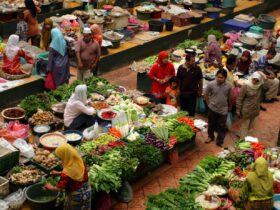What is climate-smart agriculture (CSA)?
Two of the biggest problems facing the globe now are overpopulation and climate change. By aiming for increased productivity, resilience, and a reduction in GHG emissions, climate-smart agriculture (CSA) offers a sufficient response. Higher and steadier incomes are the goal of climate-smart agricultural operations.
Apparently, the biggest problem facing the agri-food sector is producing enough food. Significant efficiency gains are needed because the amount of agricultural land that is available is limited. It is imperative that agriculture undergo a significant shift in order to maximize output with limited resources. The mitigation of greenhouse gas (GHG) emissions, on the other hand, requires particular attention due to climate change. Global temperature rises significantly as a result of its atmospheric concentration, which is expected to double by 2030. The global agriculture industry is affected significantly by this. These programs are related to one another because climate-smart agriculture (CSA) leverages the most recent technical advancements while also trying to slow down global warming.
Climate smart agriculture (CSA) is a concept that provides a range of strategies for restructuring and realigning agricultural systems to support food security in the face of climate change. These strategies emphasize the potential benefits of mitigation, adaptive capacity, and trade-offs between agricultural productivity and food security. In the long run, especially when the effects of climate change become more apparent, incremental change could not be sufficient to bring about the societal adjustments required to reduce the effects of climate change, adapt to it, and improve food security.
Climate-smart agriculture is defined by The Food and Agriculture Organization (FAO) as “that enhances achievement of national food security and development goals and sustainably increases productivity, resilience (adaptation), and reduces/removes GHGs (mitigation).”
In light of the new realities of climate change, climate-smart agriculture (CSA) is a strategy for reorganizing and changing agricultural systems to promote food security.
Three primary pillars of climate-smart agriculture:
Initiatives should be implemented in the three primary pillars of climate-smart agriculture:
- Increased revenue and output from agriculture in a sustainable manner;
- Increased resilience to climate change, both built and adapted;
- Initiatives to reduce greenhouse gas emissions
The “triple win” is achieved when these goals are successfully implemented and many creative methods are applied, leading to reduced greenhouse gas emissions, higher yields, and mitigation of climate change.
The agricultural sector is directly impacted by climate change, which can have both beneficial and negative effects (e.g., expanding agricultural production zones, and increasing the frequency of natural disasters like heat stress). Since agriculture accounts for a larger portion of emerging nations’ gross domestic products, they are more impacted. Furthermore, in contrast to developed nations, they are usually more susceptible to these kinds of changes.
Read more: What is Agricultural Technology?
Food security through climate-smart agriculture:
A large number of people, including the majority of the world’s poor, rely on agriculture for their livelihoods, and their susceptibility is increased by widespread changes in rainfall and temperature patterns that endanger this output. The food supply faces threats from population growth due to market disruptions brought on by climate change. Farmers’ adaptive capacity, agricultural production systems’ resilience, and the efficiency with which resources are used can all be improved, minimizing threats. CSA encourages integrated efforts across four primary action areas to move the agricultural, scientific, commercial, civil society, and policymaking sectors toward climate-resilient pathways:
(1) Gathering proof;
(2) Boosting institutional efficacy locally;
(3) Promoting policy coherence between climate change and agriculture; and
(4) Establishing a connection between climate finance and agriculture. The ability to develop adaptable, context-specific solutions, backed by creative policy and funding initiatives, is how CSA differs from “business-as-usual” approaches.
Read more: What is Smart Agriculture?
What is required in order to deploy CSA effectively?
Public, private, and civil society stakeholders must move quickly in four areas, from the global to the local:
(1) Developing tools for assessment and building evidence;
(2) Fortifying national and local institutions;
(3) Creating evidence-based and coordinated policies; and
(4) Boosting funding and its efficacy.
For the most part, national and local decision-makers lack access to the present evidence base, which is insufficient to support efficient decision-making. Planning at the local and national levels is inappropriate for much of the work addressing the geographical and temporal scales of how climate change affects agriculture. The reason for this is the lack of information on future changes in climate variability at such scales and their effects on agriculture, which may be far more significant for local communities than long-term trends in climate variables. These uncertainties are also related to the outputs of climate models and technical problems with downscaling models to scales that are more appropriate for decision support. Identification of strong actions in the face of uncertainty can be greatly aided by the development and deployment of problem-oriented approaches to adaptation planning. One can also take advantage of the synergies between local, regional, and global studies. Instruments are required to assess how well policies and technologies can be adapted and mitigated at local, national, and international levels. These tools should also cover the effects of extreme events as well as gradual changes on food security and agriculture, evaluate ways to make these sectors more resilient and determine the best ways to reduce emissions while keeping costs in check. At both the local and global levels, research efficacy can be significantly enhanced by using landscape methodologies and analyzing the possibilities in current foresight and scenario activities.
Finding ways to overcome the obstacles that stand in the way of adopting climate-resilient agricultural practices and concentrating on the most vulnerable—smallholder farmers, women, the impoverished, and marginalized groups—represents another significant vacuum in the body of evidence. Despite their efforts, farmers are not always adopting methods that could be advantageous in light of the changing environment. Robust studies are especially needed to help identify what constitutes “climate smartness” in various biophysical and socioeconomic situations by enhancing our understanding of what works where and why in various agro-ecologies and agricultural systems.
The second priority action area for CSA is bolstering local and national institutions to boost adaptive capacity by improving people’s access to resources, such as information. While poor planning or funding has led to varying degrees of success, institutional development has long been a key component of agricultural development efforts.
According to empirical data, governmental assistance is required in four key areas to supplement private endeavors:
- Extension and knowledge-sharing, especially with regard to applying data to modify practices to local circumstances;
- Cooperation in cases where practices have beneficial spillover effects, such as lowering the risk of floods or pest outbreaks or protecting biodiversity;
- All-encompassing risk-management plans for handling severe weather events that impact numerous farmers at once; and
- Stable, prompt, and fair access to inputs is needed to optimize resource utilization.
Reducing information costs and barriers is a major responsibility of national government, business, and civil society players. Tools like radio programs and information and communications technology (ICTs) can be employed to enhance the extension systems’ capacities to disseminate site-specific information. A lot of countries already have public and private sector players in agricultural value chains using real-time weather information from ICTs; this information might be considerably expanded to include data pertinent to CSA practices.
Read more: 4IR impact on agriculture
A growing number of people are calling for collective action in response to climate change. A lot of farmers, people in charge of communal resource management, and people in charge of public land management frequently need to work together in order to achieve the scale required to greatly reduce risks connected with catastrophic weather occurrences. To enhance tenure security over privately held and managed land, multi-stakeholder dialogues that prioritize the interests of marginalized groups, women, and the poor are a promising avenue to pursue alongside more conventional approaches. Comprehensive risk-management strategies call for coordination of efforts by public, corporate, and civil society actors at all scales, from the global to the local, as well as a deeper understanding of the robustness of various risk-management tools under climate uncertainty.
National boards that coordinate risk-management plans and institutions for risk monitoring, prevention, and reaction are examples of proactive, integrated risk management systems that national governments could offer. Risk management can be greatly aided by the private sector, but for this to happen, creative public-private collaborations and clear, effective, and enforced rules are needed. Programs for social protection, such as those that ensure minimum wages or food access, have a significant global expansion in recent years and have the capacity to influence production decisions by influencing risk exposure. Farmers may need to have access to certain inputs in order to participate in CSA programs, such as fertilizer, seeds, or tree seedlings. Widespread adoption is hampered by the absence of such inputs. Productivity and effective resource use are significantly influenced by timely access to fertilizer, which is frequently deficient. These problems can be solved by creative ways to deliver input, including ones that use ICTs.
Increasing the coordination of agricultural, environmental, and food system policies is the third priority action area for CSA, with the goal of creating enabling policy and regulatory frameworks. In order to resolve trade-offs, gaps, and overlaps, policy domains must be aligned. This can be done by communication amongst pertinent ministries. When it comes to national climate change instruments, such as nationally applicable mitigation actions (NAMAs), national adaptation programs (NAPs), and climate change investment plans, coordination is especially crucial.
Enhancing and refining the financial target in order to facilitate the shift to CSA constitutes the fourth priority action area. An essential component of these efforts is tying climate finance to conventional sources of funding for agriculture. Increased upfront investment will be necessary for agricultural system adaptation, and a key strategy for increasing financial resources is to identify and credit mitigation co-benefits produced during the adaptation process. Agriculture receives inadequate and frequently poorly targeted investment capital.
The overall amount of agricultural investment required by 2050—an estimated US$209 billion—to boost production alone to meet growing demand is still expected to be met by climate finance, even if it may rise dramatically in the coming years. The following sources of climate funding for CSA show the most promise:
(3) The Green Climate Fund (GCF);
(2) The Global Environment Fund (GEF); and
(1) The Adaptation Fund is a novel financing instrument that prioritizes the requirements of the most vulnerable populations and the prospect of direct access
With US$1.26 billion allocated to the climate change program area and US$431 million to the land degradation focal area, the GEF’s replenishment for its sixth programming term, which runs from 2014 to 2018, is US$4.43 billion. Through the use of both public and private resources, the GCF is anticipated to distribute US$100 billion annually by 2020 to cover adaptation and mitigation across all sectors.
Read more: Application of Drone in Agriculture
Contact:
If you have any questions, thoughts, or suggestions, please contact us or join our social media networks.
Email us: [email protected], [email protected]
Feel free to comment:
Your email address will not be shared with anyone.
Join our LinkedIn group
https://www.linkedin.com/groups/13943442/
Join our Facebook group
https://www.facebook.com/groups/agribusinesseducationandresearchinternational
Read More:
What is Agricultural Technology?
Application of Drone in Agriculture
Scope and Importance of Agricultural Marketing
What are the Characteristics and Traits of an Entrepreneur?
Why is market information important?
Covid -19 Pandemic Impact on Agribusiness
E-Commerce and Supply Chain Finance
Technology Application in the Financial Section of Agribusiness
Role of IT in supply chain management in Agribusiness after Covid 19 Pandemic
Agile supply chain in Agribusiness
Supply chain Management Networks in Agribusiness
Strategic sourcing for supply chain management strategy
What is the supply chain management process in Agribusiness?
What is Supply Chain Management in Agribusiness?
Supply chain Management and Agribusiness





Leave a Reply